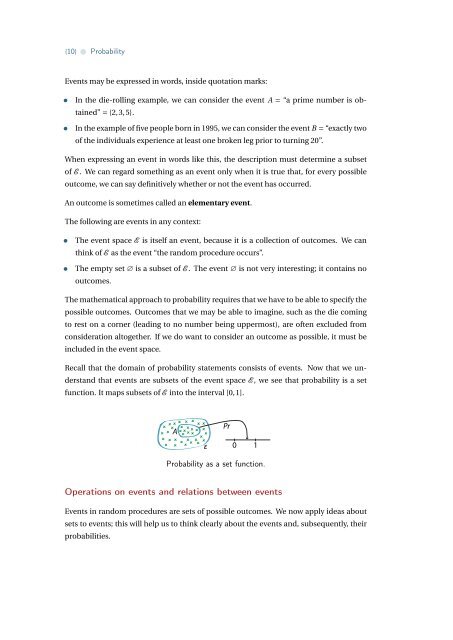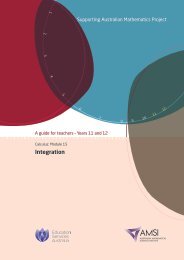Probability - the Australian Mathematical Sciences Institute
Probability - the Australian Mathematical Sciences Institute
Probability - the Australian Mathematical Sciences Institute
- No tags were found...
You also want an ePaper? Increase the reach of your titles
YUMPU automatically turns print PDFs into web optimized ePapers that Google loves.
{10} • <strong>Probability</strong>Events may be expressed in words, inside quotation marks:• In <strong>the</strong> die-rolling example, we can consider <strong>the</strong> event A = “a prime number is obtained”= {2,3,5}.• In <strong>the</strong> example of five people born in 1995, we can consider <strong>the</strong> event B = “exactly twoof <strong>the</strong> individuals experience at least one broken leg prior to turning 20”.When expressing an event in words like this, <strong>the</strong> description must determine a subsetof E . We can regard something as an event only when it is true that, for every possibleoutcome, we can say definitively whe<strong>the</strong>r or not <strong>the</strong> event has occurred.An outcome is sometimes called an elementary event.The following are events in any context:• The event space E is itself an event, because it is a collection of outcomes. We canthink of E as <strong>the</strong> event “<strong>the</strong> random procedure occurs”.• The empty set ∅ is a subset of E . The event ∅ is not very interesting; it contains nooutcomes.The ma<strong>the</strong>matical approach to probability requires that we have to be able to specify <strong>the</strong>possible outcomes. Outcomes that we may be able to imagine, such as <strong>the</strong> die comingto rest on a corner (leading to no number being uppermost), are often excluded fromconsideration altoge<strong>the</strong>r. If we do want to consider an outcome as possible, it must beincluded in <strong>the</strong> event space.Recall that <strong>the</strong> domain of probability statements consists of events. Now that we understandthat events are subsets of <strong>the</strong> event space E , we see that probability is a setfunction. It maps subsets of E into <strong>the</strong> interval [0,1].û û ûû û û û ûû û ûû û A ûû ûû ûûûû ûûû û û û û û û û ûûûεPr0 1<strong>Probability</strong> as a set function.Operations on events and relations between eventsEvents in random procedures are sets of possible outcomes. We now apply ideas aboutsets to events; this will help us to think clearly about <strong>the</strong> events and, subsequently, <strong>the</strong>irprobabilities.
















